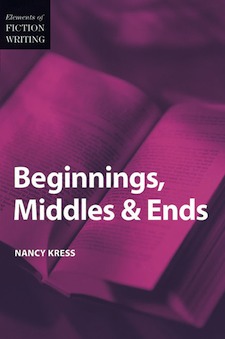There are a wealth of books on writing out in the world, from the good to the bad to the absolute nonsense—and a lot of them are by writers of speculative fiction. “Writers on Writing” is a short series of posts devoted to reviewing and discussing books on the craft that were written by SFF(&H) authors, from Jeff VanderMeer to John Scalzi. Whether you’re a beginning writer, a seasoned pro or a fan, these nonfiction outings can be good reads. They have something different to offer each level of experience, be it useful advice or just the pleasure of reading.
Beginnings, Middles & Ends is a slim tome that deals entirely with construction. It is what it sounds like: a walkthrough of how to build a story from the beginning to the middle to the end. Kress has tips and explanations for each part of a story, which she also breaks down into smaller sections when necessary. (Middles, for example, can be a fraught subject. They get all the attention they deserve.) It also contains exercises to assist the reader in understanding the content and examples.
The book is concise, but still detailed and well-explained. Kress doesn’t get caught up in digressions or lengthy examples; she uses her space wisely and to the greatest possible effect. It’s easy to understand, easy to internalize and easy to read as a whole. Her style of writing is personal and intimate, as if she is speaking directly to the reader about their process and stories. As she teaches workshops and gives lectures on writing frequently this isn’t a surprise; reading Beginnings, Middles & Ends feels a bit like attending a seminar.
There are parts of the text that seem more “beginner” than the rest—definitions of different points of view, for example—but overall, it contains useful ways of framing the idea of story construction. At one point, Kress explains the strengths and weaknesses of various formal structural designs for stories. She explains ways of shaping the narrative and what a writer can do with those potential shapes. The language she uses to do so is easy to integrate into one’s process. Instead of an instinctual choice or preference for one point-of-view over another, or one shape over another, the writer can pay more attention to the possibilities open to them.
I do love her focus on the implicit promise of a story, its necessity, and how it works. Throughout each section of the book, Kress makes sure that the reader/writer recognizes the existence of the implicit promise and understands how to nurture and develop it to completion. Her straightforward way of explaining something that might seem airy or imaginary or even impossible to a new writer is fantastic.
As a teaching tool for developing writers, this book is just right. The length makes it an accessible reference as well as a quick read. It contains neither too much nor too little information on its topic, though of course, there are deeper levels than these. Kress gives a first look at construction, the basic parts and machinery of a story. There are books that go further and deal with problems of greater complexity, but this one does exactly what it sets out to do, and that makes it a worthwhile addition to a writer’s library.
It is also especially good at one thing others often fall short on: acknowledging that every process is different, that every writer is different, and that they all need their own way of doing things. There’s no attempt to say “this is the right way, this is the only way.” Kress is aware that there’s no such thing as a right way for things like breaking a block or working through a tough scene. If it works, it works, and that’s good enough. She brings in examples from her own life and from those of other famous writers to offer possible solutions but doesn’t try to force them on the reader.
I give a thumbs-up to Nancy Kress’s Beginnings, Middles & Ends, with one caveat:
The people who are likely to get the most out of this book are beginner and amateur writers. The amateur is good at putting words together in aesthetically pleasing ways. They can write good stories, but it’s all instinct. The amateur doesn’t have the vocabulary or the tools to figure out why some stories work and why some don’t, they just know it happens. They’re ready to move past the basics and into the substructures of their craft, the mechanics that keep the whole thing going. Beginnings, Middles & Ends is just about perfect for that writer. It might be a fun afternoon read for someone farther in their career, or give them a different way to phrase something they already understood, but they’re not likely to learn anything surprising or new.
It’s also a sort of bookend-text in that it addresses only one subject. It’s a necessary and hugely important subject to the act of storytelling, but it’s still a narrow focus. So, while no book on writing should be read in isolation, this one especially needs companions that deal with things like language, character, setting, etc. to build a full picture for the curious learner. That’s not to say it’s not a great book, because it is, just that the developing writer should be careful not to neglect other aspects of the craft not discussed therein.
Lee Mandelo is a multi-fandom geek with a special love for comics and queer literature. She can be found on Twitter and Livejournal.










